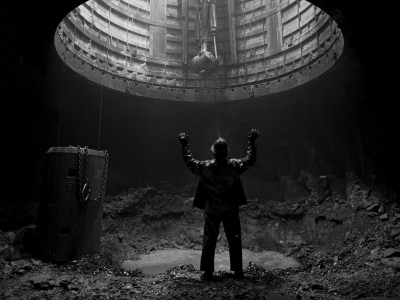The portraits in Louie Palu’s new Art Gallery of Sudbury exhibit are striking: a man gazing pensively into the distance, a stump where his arm should be; a couple laughing over a few beers in a Timmins tavern the night before a shaft-sinking trip to Mexico; a pair of miners pausing for lunch underground amidst the grime and solitude, coffee in their thermos and a pinup girl on the wall.
This is the reality of hard-rock mining in the North.
Cage Call: Life and Death in the Hard Rock Mining Belt features a selection from Palu’s 12-year project documenting the culture of hard-rock mining in Northern Ontario and Que. communities. The black-and-white photographs capture day-to-day life in and around the mines of Timmins, Sudbury, Kirkland Lake, Virginiatown and Val d’Or, Que., providing insight into a world that most of us will only see in pictures.
“I think exhibitions are an important way of having a dialogue, because dialogue keeps us smart and up to date on the issues we need to always be discussing, like health and safety, strong positive relations between a company and the community they operate in, the environment, and issues around resource extraction and the economy they contribute to,” Palu said.
“We all have a stake in that, even if we don't work for a company or are a member of a union, because we all live together and are connected.”
Palu embarked on the project in 1991, after his father’s suggestion to photograph gold miners in Kirkland Lake. He collaborated with Timmins-James Bay MP Charlie Angus, who interviewed miners about their experiences, and their work was published in book form in 2006. It’s the third in a series on mining the pair published.
Throughout the experience, Palu and Angus developed close personal ties with the miners and professional relationships with the mining companies and unions. Although the unions were helpful, “some companies were great, and some were completely out of touch with their community,” Palu said.
Angus recalled how, during its early efforts, the pair had to sneak into the mines to gain access, Angus once pretending to be a worker’s cousin while hiding his tape recorder under his arm. But once the companies, which are sensitive about the industry’s portrayal, understood the scope of the project, most welcomed the pair in to archive the underground way of life.
“I love the culture, and the work’s been great, but it exacts a heavy toll,” Angus said, noting that some material was excised from the final product to avoid sensationalism. “Even though it’s much safer now, these are all very modern stories.”
While writing their first book, a photo documentary of mining landscapes, Palu and Angus thought they were documenting the disappearance of mining, which was considered a sunset industry and hadn’t experienced any development in decades, Angus said. But that changed with Cage Call.
“As we were writing, the industry was reborn before our eyes, which was fascinating to watch,” Angus said.
Tom Smart, the gallery’s special advisor for curatorial programs, said the work had all the elements he wanted in an exhibit: art, history, culture, industry, economics and the North.
“It was exactly what I was looking for: an artist working with a community, interpreting the community artistically, poetically, and also documenting in a kind of journalistic way,” he said.
The gallery is collaborating on the project with Dynamic Earth, which has more of Palu’s photographs on display.
Palu was struck by how the mining culture differed between communities, but what reverberated throughout was the trust and openness the miners handed him and Angus as they recorded some of their most personal moments.
He hopes that intimacy will resonate with those who see the exhibit.
“Reflection, education and dialogue are my goals,” Palu said. “I think for there to be balance in how we learn and understand an issue we need many different views of our world. The companies, unions and government have many different images we can learn from on how mining impacts our lives. I am somewhere in the middle of those views working as an artist and photojournalist.”
The Cage Call exhibit will run until Nov. 18.




